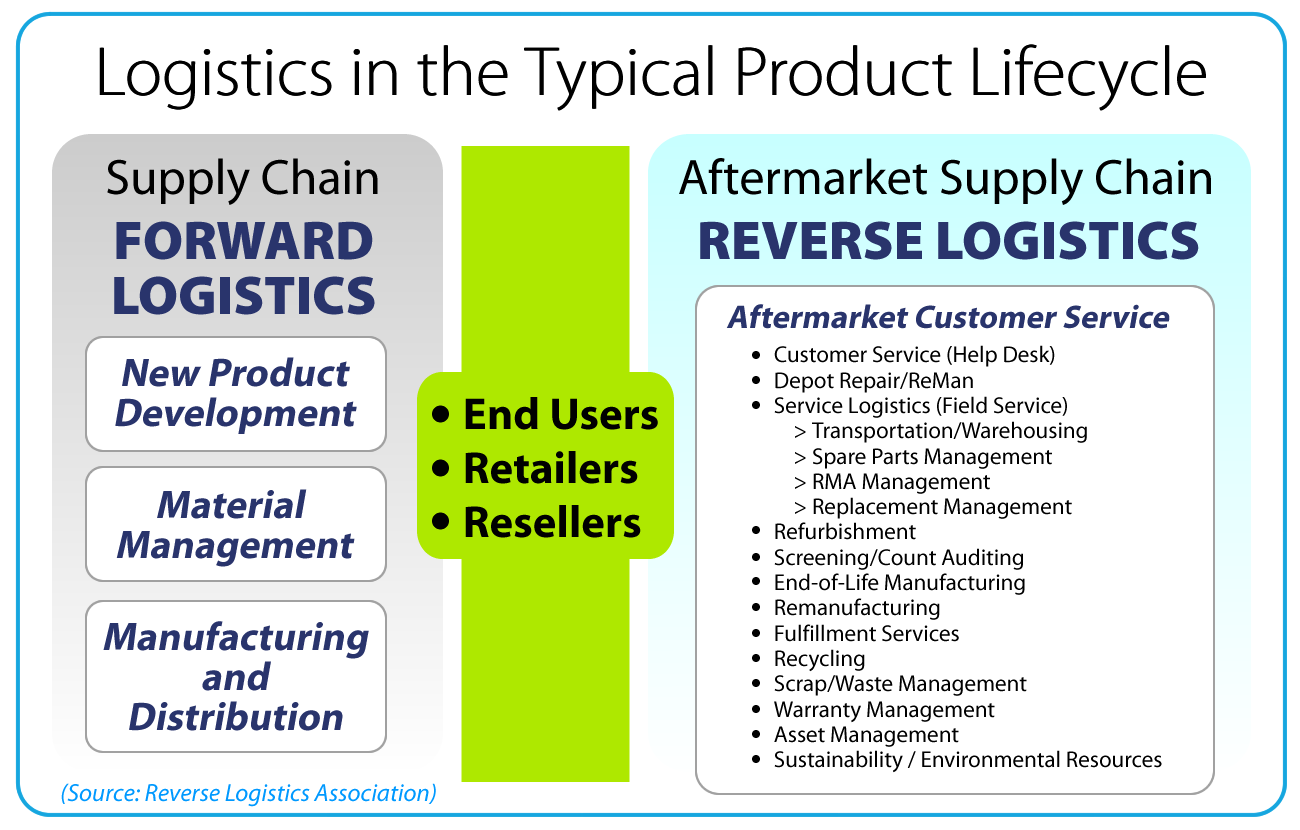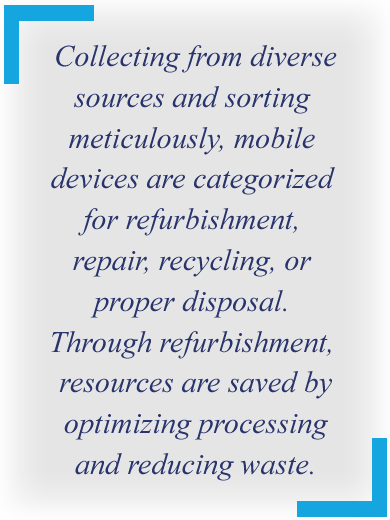(8.24.2023)
The FutureDial Blog

TAKEAWAY: "Reverse logistics" has gained momentum, with an annual expenditure of $750 billion in North America alone. It optimizes post-sale processes for cost and environmental gains, reclaiming value from used products. Mobile device reverse logistics is key, managing end-of-life devices for disposal, refurbishment, or recycling, vital due to increased phone returns. Mobile device reverse logistics emerges as a pivotal force in the mobile supply chain, redirecting preowned devices to recover renewed value. Automated solutions merging device processing systems on the backend and real-time data insights from operations have enhanced profitability, and are paving the path for a responsible circular economy, maximizing preowned mobile devices' renewed value.
What is “Reverse Logistics”?
The concept of "reverse logistics" has gained immense traction in recent years, evident by the staggering $750 billion spent annually on it in North America alone. Despite the considerable investment, the definition of reverse logistics has proven elusive, with various attempts to encapsulate its essence. According to the Reverse Logistics Organization (RLA), reverse logistics encompasses "all activity associated with a product or service after the point of sale, the ultimate goal being to optimize or make more efficient the aftermarket activity, thus saving money and environmental resources."
To visualize the relationship between forward logistics (the supply chain) and reverse logistics (the aftermarket supply chain), refer to the chart below:

Interchangeable terms for reverse logistics include "aftermarket logistics," "retrogistics," and "aftermarket supply chain." Reverse logistics commonly involves activities such as shipping, warehousing, repair, refurbishment, recycling, e-waste management, aftermarket call center support, reverse fulfillment, field service, and more.
Gailen Vick, Founder Emeritus of the Reverse Logistics Association, encapsulated the financial essence of reverse logistics, describing it as “any operation that draws from a company's warranty reserve or service logistics budget.” He further elaborated that reverse logistics is a systematic process transcending departments and industries, aiming to manage assets comprehensively.
What is “Mobile Device Reverse Logistics”?
![]() This article focuses on the dynamic world of mobile device reverse logistics, examining its intricacies, processes, and environmental significance. As technology continuously evolves, mobile devices have become indispensable, prompting companies to consider efficient and sustainable lifecycle management strategies.
This article focuses on the dynamic world of mobile device reverse logistics, examining its intricacies, processes, and environmental significance. As technology continuously evolves, mobile devices have become indispensable, prompting companies to consider efficient and sustainable lifecycle management strategies.
Among these strategies, mobile device reverse logistics emerges as a vital component, involving the management of used or end-of-life mobile devices, directing them from consumption back to manufacturers or designated facilities for proper disposal, refurbishment, or recycling. Diverging from traditional logistics, reverse logistics orchestrates the reverse movement of products through the supply chain, optimizing value recovery while minimizing waste.
The Rise of Mobile Device Returns
The ongoing surge of mobile devices in consumer markets permeates various stages of the global supply chain, impacting warehousing, distribution, transportation, and more. Notably, mobile devices comprise a significant fraction of returns for service providers, leading to exponential growth in quarterly returned device volumes. Research highlights the pivotal role of repair, return, and refurbishment operations in an organization's financial and operational success.
Key Processes in Mobile Device Reverse Logistics
Collection and Sorting:
The initial step involves collecting used mobile devices from various sources, including consumers, retailers, and even corporate clients. Sorting plays a crucial role, as devices are categorized based on factors such as brand, model, condition, and functionality. This classification helps determine the appropriate next steps, whether it's refurbishment, repair, recycling, or disposal.
Secure Data Erasure:
 Before any device is refurbished or recycled, it is crucial to ensure the secure erasure of any personal and sensitive data. This involves wiping the device's memory and storage to prevent unauthorized access to personal information. There are many industry-grade and military-grade data sanitization standards in use to perform the data-clearing of preowned devices.
Before any device is refurbished or recycled, it is crucial to ensure the secure erasure of any personal and sensitive data. This involves wiping the device's memory and storage to prevent unauthorized access to personal information. There are many industry-grade and military-grade data sanitization standards in use to perform the data-clearing of preowned devices.
Refurbishment and Repair:
Devices that can be refurbished or repaired undergo meticulous processes to restore them to functional condition. This includes replacing damaged components, enhancing the cosmetic appearance, fixing software issues, and ensuring overall performance optimization. Refurbished devices are often graded and resold, reducing the need for new manufacturing and minimizing electronic waste.
Recycling:
Mobile devices contain valuable components like metals, plastics, and rare earth elements. Recycling involves extracting these materials for reuse in new products. Recycling not only conserves natural resources but also reduces the environmental impact associated with mining and manufacturing raw materials.
Disposal:
For devices that are beyond repair or refurbishment, responsible disposal is essential. Improper disposal can lead to environmental pollution and health hazards. Ethical and environmentally-conscious disposal methods ensure that hazardous materials are safely managed and minimized.
From Chaos to Efficiency: Solving Mobile Device Logistics Challenges
As the surge in mobile device trade-ins, buybacks, damage and replacements disrupts the reverse logistics cycle, this necessitates the implementation of efficient solutions, such as automated tools to streamline refurbishing operations. These tools address the challenges faced by mobile device reverse logistics service providers, who grapple with processing numerous device models using varied support tools and manual procedures. Such inefficiencies lead to extended turnaround times, inadequate tracking, and incomplete data scrubbing.
Automated solutions are stepping in, offering comprehensive mobile device refurbishment and supply chain management options. These solutions streamline operations and formerly manual processing tasks, optimize revenue growth, reduce costs, and enhance customer experiences. Leading supply chain service providers are also offering integrated post-sale solutions, merging device return management, repair experiences, and value recovery intelligence to maximize the potential of returned and excess inventory.
Automated Success: Boosting Profitability through Integrated Asset Workflows
In the future, automated solutions are expected to intertwine more seamlessly with service providers' backend inventory management and tracking systems. This integration would allow service providers to incorporate incoming asset inventory directly into automated refurbishing solutions, creating a cohesive workflow.
Enhanced visibility into processes is facilitated by integrated dashboards, empowering management and decision-makers with real-time insights into line operations. This heightened transparency ultimately leads to increased profitability and improved outcomes for service providers leveraging automated solutions in mobile device reverse logistics.
Reclaim, Refurbish, Repeat: Mobile Device Reverse Logistics Powers Circularity
Mobile device reverse logistics is a critical facet of our technology-driven society. It not only maximizes the value recovery of used devices but also contributes significantly to environmental sustainability. As we grapple with electronic waste and dwindling resources, adopting reverse logistics principles can pave the way for a more responsible and circular economy.
Profit-Boosting Solutions for Mobile Device Reverse Logistics
Businesses engaged in preowned mobile device reverse logistics partner with FutureDial for innovative processing automation solutions. These solutions enhance operational efficiency for processing high volumes of devices, increase profitability, and ensure competitiveness in the market. Whether you're a refurbisher, reseller, trade-in provider, wireless carrier, or another business in the mobile device reverse logistics supply chain, FutureDial's cutting-edge technology can elevate your processes and drive growth. Reach out to FutureDial at sales@futuredial.com to explore how their solutions can revolutionize your operations.
© 2023 FutureDial Incorporated. All Rights Reserved.

